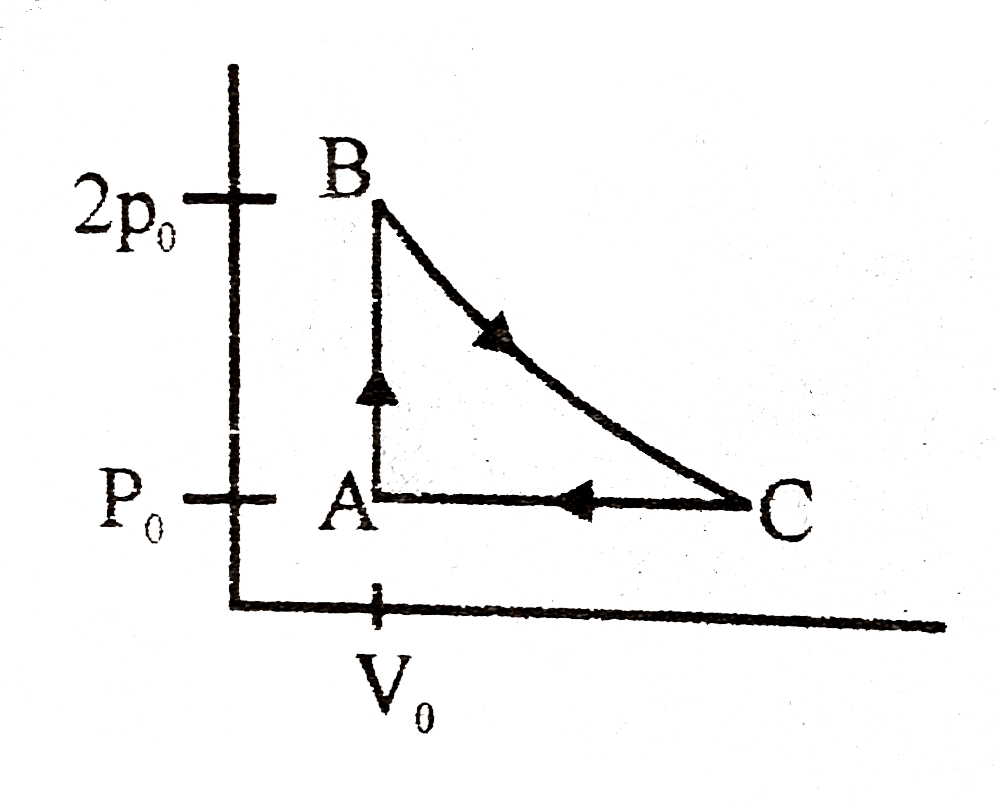An ideal gas has pressure p0, volumn V0 and temperature T0. It is taken by an isochoric process till its pressure is doubled. It is now isothermally expanded to get the original pressure. Finally , the gas is isobarically compressed to its original volume V0.
(a) Show the process on a p−V diagram.
(b) What is the tempertaure in the isothermal part of the process?
(c) What is the volume at the end of the isothermal part of the process?
(a) The process is shown in a p−V diagram in figure. The process starts from A and goes thourgh ABCA.
(b) Applying pV=nRT at A and B,
p0V0=nRT
and (2p0)V0=nRTB
Thus, TB=2T0
This is the temperature in the isothermal part BC.
(c) As the process BC is isothermal, TCTB=2T0.
Applying pV=nRT at A and C,
p0V0=nRT
and P0VCnR(2T0)
VC2VC
Topper's Solved these Questions
- BOOK - BANSALCHAPTER - KINETIC THEORY OF GASESEXERCISE - Practice Exercise3videos
KINETIC THEORY OF GASES
- BOOK - BANSALCHAPTER - KINETIC THEORY OF GASESEXERCISE - Exercise 141videos
KINETIC THEORY OF GASES
- BOOK - BANSALCHAPTER - KINETIC THEORY OF GASESEXERCISE - Section-B13videos
KINETIC THEORY OF GASES
- BOOK - BANSALCHAPTER - HEAT TRANSFEREXERCISE - Exercise89videos
HEAT TRANSFER
- BOOK - BANSALCHAPTER - UNIT DIMENSION, VECTOR & BASIC MATHSEXERCISE - Exercise10videos
UNIT DIMENSION, VECTOR & BASIC MATHS
Similar Questions
An ideal gas has pressure p0, volumn V0 and temperature T0. It is taken an isochoric process till its pressure is doubled. It is now isothermally expanded to get the original pressure. Finally , the gas is isobarically compressed to its original volume V0. (a) Show the process on a p-V diagram. (b) What is the tempertaure in the isothermal part of the process? (c) What is the volumn at the end of the isothermal part of the process?
View SolutionA sample of an ideal gas has pressure p0, volume V0 and tempreture T0. It is isothermally expanded to twice its oringinal volume.it is then compressed at constant pressure to have the original volume V0. Finally, the gas is heated at constant volume to get the original tempreture.(a) show the process in a V-T diagram (b) calculate the heat absorbed in the process.
View Solution
Knowledge Check
- Question 1 - Select One
A mass of ideal gas at pressure P is expanded isothermally to four times the original volume and then slowly compressed adiabatically to its original volume. Assuming γ to be 1.5, the new pressure of the gas is
A2PBPC4PDP/2 - Question 2 - Select One
One mole of a monatomic ideal gas has an initial pressure, volume, and temperature of P0,V0, and 438 K, respectively. It undergoes an isothermal expansion that triples the volume of the gas. Then, the gas undergoes an isobaric compression back to its original volume. Finally, the gas undergoes an isochoric increase in pressure, so that the final pressure, volume, and temperature are p0V0 and 438 K, respectively. Find the total heat for this three-step process, and state whether it is absorbed by or given off by the gas.
A3640J absorbedB−1820 J given offC1570 J , absorbedD−1110J , given off - Question 3 - Select One
A gas is suddenly compressed to one fourth of its original volume. What will be its final pressure, if its initial pressure is p
ALess then pBMoer then PCpDEither(a) or ©
An ideal gas intially has pressure P volume V and temperature T. Its is isothermally expanded to four times of its original volume, then it is compressed at constant pressure to attain its original volume V. Finally, the gas is heated at constant volume to get the original temperature T. (a) Draw V−T curve (b) Calculate the total work done by the gas in the process.(given ln2=0.693)
View SolutionThree moles of an ideal gas (Cp=7/2R) at pressure pA and temperature TA is isothermally expanded to twice its initial volume. It is then composed at constant pressure to its original volume. Finally the gas is compressed at constant volume to its original pressure pA (i) Sketch p−V and p−T diagrams for the complete process (b) Calculate the net work done by the gas and net heat supplied to the gas a during the complete process.
View SolutionAn ideal gas with pressure P, volume V and temperature T is expanded isothermically to a volume 2V and a final pressure Pi, If the same gas is expanded adiabatically to a volume 2V, the final pressure Pa. The ratio of the specific heats of the gas is 1.67. The ratio PaP1 is .......
View SolutionThree moles of an ideal gas (Cp=72R) at pressure, PA and temperature TA is isothermally expanded to twice its initial volume. It is then compressed at constant pressure to its original volume. Finally gas is compressed at constant volume to its original pressure PA.
(a) Sketch P-V and P-T diagrams for the complete process.
(b) Calculate the net work done by the gas, and net heat supplied to the gas during the complete process.View SolutionA certain mass of an ideal gas is at pressure P1 and volume V1. If is compressed isothermally and then allowed to expand adiabatically untill its pressure returns to P1. The gas is then allowed to expand its original volume. Which of the following P−V graphs are these process correctly shown?
View Solution
